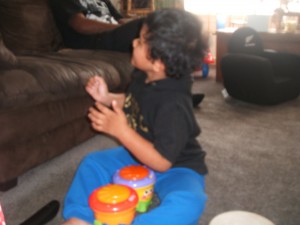Arama is a four year old student who is blind. He is learning to communicate with others through music. He is using a drum as this is a familiar and motivating instrument for him.
Dolina Butler (BLENNZ Resource Teacher for Vision) describes how she has used the drum to support Arama’s communication skills. In figure 1 Arama is singing and moving to the music his electronic drum plays
What is happening now?
A drum was chosen because this was an instrument Arama was familiar with and felt safe with.
After having time to play his own drum independently, Arama is given a large skin drum to explore and then share with his Resource Teacher Vision.
Dolina played the drum and Arama imitated this action. In figure 2 Arama explores and experiments with the new drum.
Figure 3 Arama imitates Dolina’s drumming actions
Prerequisite skills
Arama needed to be able to listen to the sound of the beat of fingers on the drum.
Arama needed to know how to use his fingers to make a rhythm pattern on the drum.
Possible next steps
- To continue to experiment with different rhythm patterns he can make on the drum.
- To practise taking turns with an adult on the drum.
- Arama to participate in a call-response rhythm game.
- Arama imitates a basic rhythm pattern modelled by an adult.
- Arama to make a rhythm pattern on the drum and an adult to imitate it.
- To introduce Arama to a new instrument which he finds motivating.
Teaching methods and strategies
- I worked with Arama with his drum at home where he felt safe, secure and relaxed.
- I asked Arama to play his drum to me.
- I played his drum.
- I introduced Arama to the new drum and gave him time to explore it
- I modelled how to play the new drum. I chanted to Arama about what I was doing as I played the drum.
- I allowed Arama time to respond – I waited quietly until Arama chose to have a turn playing the drum.
- I chanted to Arama about what he was doing as he played the drum.
- We shared beating on the drum together.
Learning adaptations
Providing under elbow support to encourage Arama to explore and play the drum
The use of clear and simple language to encourage Arama to explore and play the drum, and to describe his actions while he played the drum.
Assessment
During my visits to Arama’s home and his attendance at playgroup I have observed Arama and recorded his learning and development in learning story format in relation to Communication goals in Te Whaariki the Early Childhood Curriculum document.
Learning resources
- Drum, musical instruments
Useful Links
- Music therapy and the Visually Impaired Child – Alanna Sousa and Nicole Dickenson: Prezi.com presentation.
- Inside Story: Music – Perkins School for the Blind.
- About music therapy – Raukatauri Music Therapy Centre.
More information
Email us at BLENNZ for more information about this subject.
We will link you up with either the author of this post or another BLENNZ colleague with whom you can continue your conversation.



